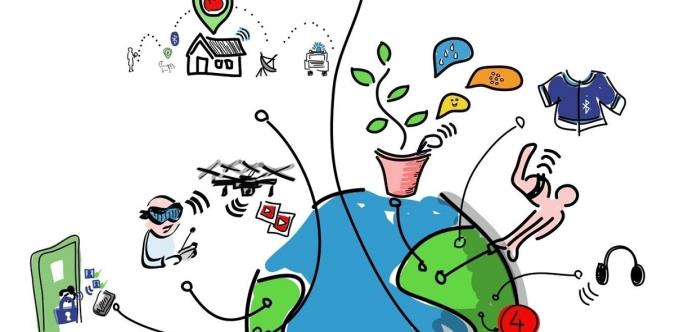The IoT, Blockchain,and Ownership in the digital world
The IoT, Blockchain, and Ownership in the digital world
This article discusses the need to use blockchain (a large-scale data entry and storage system). As a program to secure the “Internet of Things” IoT. As well as the interference of intellectual property and customer ownership of the purchased product.
We have many interconnected devices in the world today, and this number will increase in the future. The number of thermostats, cameras, streetlights, and other electronics equipped with the Internet in 2017 was estimated at 8.4 billion. In 2020, this number will reach more than 20 billion, and by 2030, it could reach more than 500 billion.
Since all of these devices are always connected to the Internet, each (e.g., voice and speech recognition device, telephone parking meter, temperature sensor in an industrial robot). It is vulnerable to cyber-attacks and against them. They are vulnerable, and even any of this equipment can be used in a cyberattack and be part of it.
Today, many smart devices connected to the Internet are made by big and well-known commercial companies such as Google, Apple, Microsoft, and Samsung. These devices are equipped with the latest technologies and, on the other hand, have created markets to solve their security problems quickly.
But this is not the case in today’s crowded world, which includes many small devices connected to the Internet. Examples of such devices include lamps, light bulbs, doorbells, and devices for moving packages using UPS (Continuous Power Supply Systems) systems. Unknown companies typically make these devices and their digital cores. Many are located in developing countries, without known funding or branding, or even without strong security features.
If we do not have the right to control our own devices, we do not own them.
Part of the IoT is related to devices that are not secure enough. And the use of these devices has caused major cyber disasters.
Like the October 2016 cyberattack on Dyn’s Internet routing company. Which destroyed more than 80 popular websites and halted Internet traffic in the United States. Researchers in IoT technology, blockchain systems, and cybersecurity see the solution to this problem as inventing a new way to track and distribute security software using the blockchain system.
Security must be a priority.
Today, big tech companies are working hard to keep users safe, but their job is very difficult because thousands of complex software packages run on different systems worldwide. And each has a different error rate that puts them at risk of being hacked. Puts. They also have teams of security researchers and analysts who try to identify flaws before they cause a problem and fix them.
These teams become aware of device vulnerabilities (through their research or user reports of malicious activity). They update the programs and then send them to users. Computers, phones, and even many of these companies’ software programs are periodically connected to manufacturer sites, making updates. And they can even download and install updates automatically.
Doing so requires specialized people to follow up on problems and make necessary corrections, as well as huge investments. To do this, we need software to automatically answer questions, storage space for new versions of software, and network bandwidth to send information quickly to millions of users. iPhones, PlayStation devices, and Word versions of Microsoft are all constantly updated in this way, and their security errors are constantly being corrected.
A Potential Solution to this problem
In simple terms, blockchain records computer transactions simultaneously in different locations. In other words, the system is like a public bulletin board where people can post notifications of their transactions. Each post must have a digital signature and never be deleted or changed.
Researchers suggest using blockchain systems to improve and increase the security of devices connected to the Internet. In January 2017, a group consisting of a large American network called Cisco, German engineering company Bosch, New York Mellon Bank, Chinese electronics maker Foxconn, Dutch cybersecurity company Jamalto and several startups in blockchain achieved this. The goal was to increase the security of the devices.
Like large technology companies, device makers can now build blockchains to upgrade their software using blockchain. These smaller companies need to plan their products in such away. They periodically search for new software using the blockchain system and then securely update themselves. Each device has a strongly encrypted identity to ensure that the device is properly connected to the manufacturer. As a result, device manufacturers and their customers have the tools to update the security of their devices.
The Importance of External Pressure
It is not enough to develop blockchain-based systems that can protect IoT-enabled devices. If device manufacturers do not use these systems, the cyber security of all users remains at risk. Companies that make low-cost devices for a small profit do not add protective layers to their devices without outside help and Support. They need technology and government regulation to enforce consumer rights to change their current practices.
When unknown manufacturers are not well-known, they face failure to sell their products due to low security. They conclude that they will not buy until their products are more secure, so this group of IoT manufacturers. They will improve and improve the security of users and the Internet space.
Does IoT technology take us back to the Middle Ages?

As mentioned, Internet-enabled devices are so common and so vulnerable that hackers have recently been able to hack into a casino system through a fish tank. The tank had sensors connected to the Internet to measure temperature and water hygiene. The hackers entered the fish tank sensor system and then connected it to the computer that controlled the sensors. And from there to other parts of the network. The attackers were able to copy 10 gigabytes of data related to the network to a location in Finland.
By looking closely at this fish tank, we can see the problem with IoT-enabled devices: in fact, we do not control them. And it is not always clear who does it, although most software designers and advertisers do. Work is involved.
Smart devices can be programmed to share our private information with advertisers through secret channels we are unaware of.
There are Breaches of Security and Privacy in the construction of these devices.
Like Roomba, other smart devices can be programmed to share our private information with advertisers through secret channels we are unaware of. Another example is Wei Web, controlled by a smartphone that collects information about the number of uses per day, hours of use, and settings. His Web app sent the data to its creator. And when customers found out. They complained about the privacy breach, and the developer had to pay several million dollars in damages.
These secret channels are a serious security vulnerability. Lenovo subsidiary maker, for example, used to sell its computers with a program called Superfish that was already installed on them. The program’s purpose was to allow Lenovo, or other paid companies, to sneak targeted ads into users’ Internet search results. The way this program worked was quite dangerous: it hijacked Internet browser traffic without the user’s knowledge. This information included Internet communications that users thought were securely encrypted. For example, users used gateways to banks and online stores to conduct financial transactions while these communications were not secure.
The Main Problem is Ownership
We do not control our devices because companies think and act in a way they still own, even after purchasing them. By purchasing an electronic device such as a smartphone, the individual has only purchased a license to use the software. These companies say they still own the software and therefore can control it. It is like a car dealer selling a car and still claiming ownership.
This type of planning destroys the concept of basic ownership of assets. John Deer has previously told farmers that they do not own their tractors. But only have a license to use the software, so they can not repair their farm equipment or even take it to an independent repair shop for repair. Farmers disagree, but some people may want to skip smartphones when it comes to smartphones. These devices are often purchased in installments and traded quickly and instantly.
How long does it take to realize they intend to apply the same rules to our smart homes, smart TVs in our living rooms and bedrooms, smart toilets, and cars equipped with our Internet?
Return to Feudalism
The ownership and control of equipment and property have a long history. In the system of sectarian monarchies in medieval Europe, the king owned almost everything. And the property rights of others depended on their relationship with the king. The peasants lived on land donated by the king to the local lord, and the workers did not always own tools used in agriculture or other trades, such as carpentry and blacksmithing.
Blockchain records computer transactions simultaneously at different locations.
It seems that with the expansion of the Internet of Things. We are returning to the old model of the sectarian monarchy, where people did not own the items they used. In the 21st-century sectarian monarchy model, companies use intellectual property law to control things to protect their ideas physically. While consumers assume they own their things.
Intellectual Property Management
For example, in the case of Samsung phones, Google controls the operating system, and Google applications make Android smartphones work well. Google allows Samsung to use these apps, and Samsung makes the desired changes to the Android interface. And allows them to use people’s phones; this is the argument of Google and Samsung. Samsung works with many software providers who want to obtain user information.
But this model is not perfect. Individuals and users should have the right to repair their equipment. We should have the right to remove annoying advertisers on our devices. We have the right to close the secret channels that send our information to advertisers, not only because we do not want them to spy on us. But also because these secret channels pose a security risk, as the story of Superfish and the hacked fish tank showed. If we do not have the right to control our own devices, we do not own them. We are the digital peasants who have bought and used the equipment from our digital masters at their desired price.
Part of the Internet of Things is related to devices that are not secure enough.
Conclusion
In recent years we have seen progress in regaining ownership of digital masters. It is important to identify and reject what these companies are trying to do. To buy according to our needs. And to strongly defend our rights to use, repair, and modify our smart assets and to strive to achieve Support these rights. The idea of ownership is still strong in our cultural imagination and will not be easily destroyed. And if we take this opportunity, we can defend our rights as consumers.











